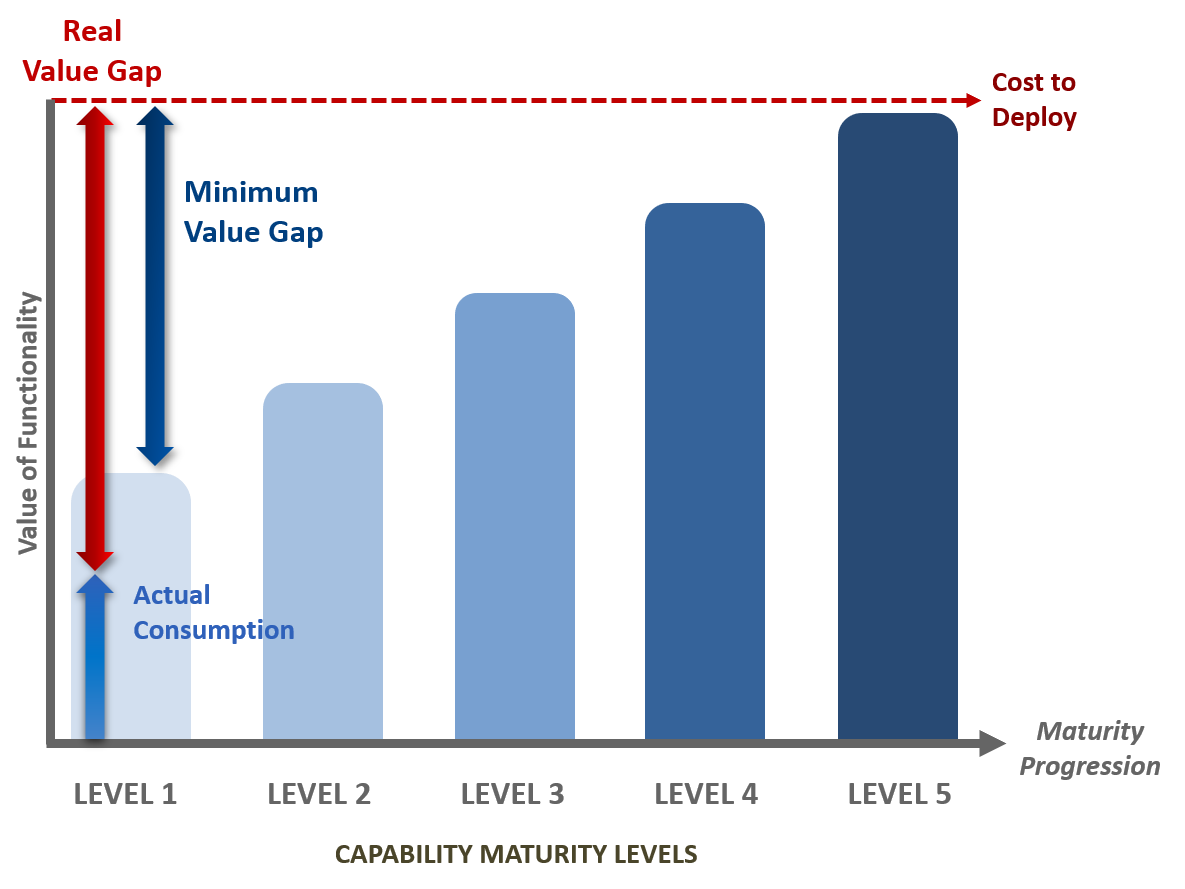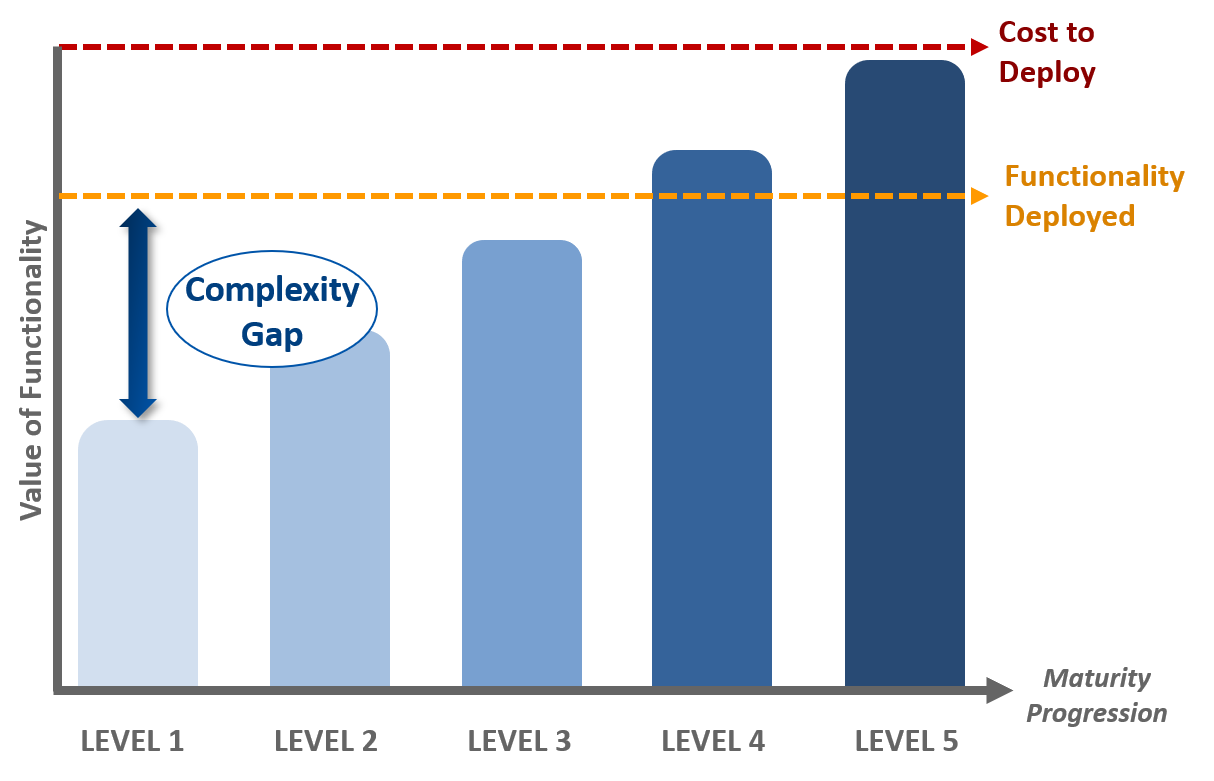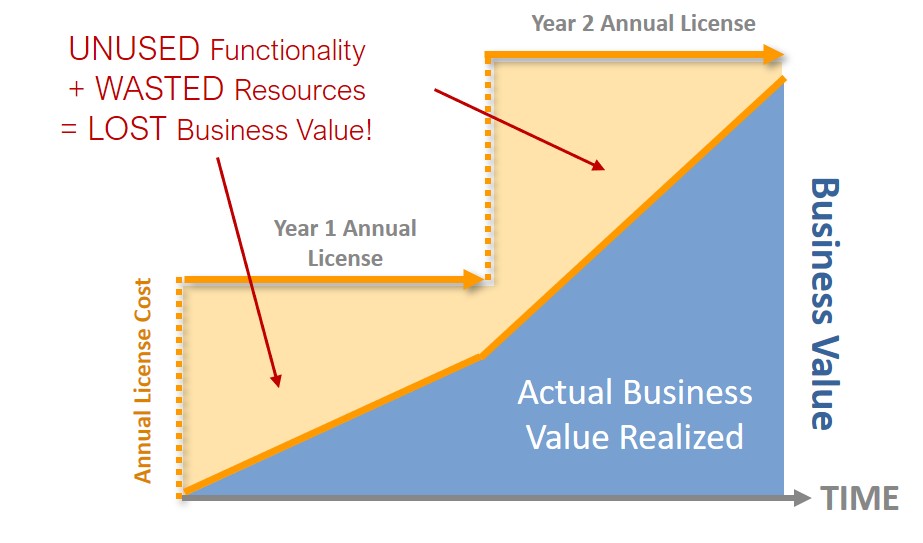The Value Gap of Today’s PPM Software Is Worse Than You Think
PPM Software Challenges
The vast majority of project portfolio management (PPM) software utilizes a traditional licensing model and is expensive relative to the value customers get from the software. There has been little innovation in the licensing model for PPM software since 2008 (when software-as-a-service started growing in popularity), and this is holding project management offices (PMO’s) back. Due to the extensive cost and complexity of the offerings, early-stage PMO’s that wanted a digital solution had to consider their future software needs in relation to future processes that they intend to implement (but may never actually adopt). The result often turned out to be cumbersome PPM software that was over-kill for many organization and in some cases, a very expensive paperweight.
In contrast, project management software has expanded greatly in recent years to include a wide variety of offerings at multiple price points, multiple licensing models, with varying degrees of functionality. This makes it far easier for projects teams with different levels of experience and skillsets to find a solution that works best for that team.
PPM software differs from project management software and has a strategic focus. PPM software includes capabilities such as: project tracking, status reporting, portfolio roadmapping, portfolio analysis and reporting. More advanced functionality includes: work intake, resource capacity planning, prioritization, and portfolio planning.
Every Project Management Office (PMO) needs to track projects and collect status from the beginning. Unfortunately, most organizations start out using spreadsheets and slide decks, which are static, manual, and time consuming. Today, PMO’s are forced to take a giant leap from using inexpensive basic tools to expensive and heavy PMO software. Just as Project Managers have many options for managing projects, PMO Directors should have better options as well. Companies should not have to decide between cheap and manual versus expensive and cumbersome. Newer PMO’s deserve a digital solution that not only fits their state of maturity but also enables them to scale at their pace with a true cost proportionate to their true usage.
PPM Software Problem #1 – The Value Gap
The majority of Project Management Offices (PMO) overpay for their PPM software and don’t even realize it! Most PMO Directors do not even consider the “value gap”, which is the gap between the cost to deploy PMO software and the actual value derived from the software. The value gap highlights how broken the current PPM software licensing model is. Today, most PPM software is developed to cover a wide variety of use cases which means that a lot of software functionality is needed. Software vendors have to pass on these development costs to their customers whether or not the customer needs the functionality.
The PPM Software Value Gap Chokes PMO Value Delivery
Moreover, most PMO’s do not fully utilize all the functionality because of their current capability maturity level. A maturity level represents the level of sophistication in the processes, tools, and people involved in the PMO. According to Gartner, around 80% of PMO’s are level 1 or 2 maturity. Let that sink in. The overwhelming majority of PMO’s are new or have slowly matured and can only utilize a limited amount of functionality. Companies should pay for what they need, not pay for what they don’t need. That’s the tragic reality of the value gap – newer PMO’s can successfully utilize a fraction of the software functionality they are paying for. They pay the software vendor full price for functionality which they may never use.
The overwhelming majority of PMO’s are new or have slowly matured and can only utilize a limited amount of functionality. Companies should pay for what they need, not pay for what they don’t need.
The graphic below shows us the first part of the value gap challenge. The X-axis refers to the five capability maturity levels of a PMO and the conceptual maturity progression from level to level; the Y-axis represents the value of the functionality at each level of maturity. We are drawing a correlation between the level of usage and software value. The more PPM software is successfully utilized, the more valuable it becomes. However, today’s PPM software is very robust, but by definition a level one or level two maturity organization can only utilize a limited set of features. At each maturity level there is a limit to how much functionality can be successfully utilized, this is the “minimum value gap”. As organizations develop and mature, this minimum value gap gets smaller because they can utilize more features successfully.

As a simple comparison, grade school children learn how to use a basic calculator for addition and subtraction and have no need for a graphing calculator commonly used for calculus. Introducing a graphing calculator to grade school children is complex, expensive, and unnecessary. The student only needs a basic calculator to do basic math. The same holds true for PMOs and PPM software. PMO Directors should be equally vigilant to give their early-stage PMO’s the right software to match their maturity level; anything more is a waste of money and a drain of resources. [CHECK OUT the new PPM Maturity Assessment tool]
The Real Value Gap
For each designated maturity level there is a minimum value gap. However, in practice, companies may get even less value than expected due to poor user adoption. This means that the actual utilization (consumption) of the software is less than expected. The real value gap is therefore even greater than the minimum value gap. In other words, when companies fail to utilize PPM software to their full ability, they get even less value than they expected. The graphic below depicts the real value gap. It is critical for PMO Directors to recognize this value gap and manage user adoption accordingly. Without user adoption there is no value.
Their current maturity level dictates or restricts how much of the functionality they can successfully utilize. When companies are unable to successfully utilize even the basic functionality we say that the real value gap is greater. PMO directors need to be aware of this value gap when evaluating PPM software. When a PMO director is considering the purchase of PPM software they strongly need to consider the value gap. It is foolish to buy anything that is far more expensive than what you need. PMO Directors need to evaluate their current state maturity and identify software that matches their current maturity level and allows them to grow into that solution. Buying a complex and advanced solution in order to “plan for the future” is a waste of time and a drain of organizational resources.

PPM software providers do not talk about the value gap in the sales process. This is also problematic and a red flag for PMO Directors. The responsibility for getting value from PPM software should be shared by the customer and the vendor. We’ve seen Fortune 500 companies with good intentions waste hundreds of thousands of dollars on PPM software that was too complex compared to their current state of maturity. This leads us to the second problem with current PPM software – the complexity gap.
PPM Software Problem #2 – The Complexity Gap
The complexity gap takes this problem one step further. When companies do realize the high cost of PPM software, they often do the worst thing possible – they deploy more functionality than they are capable of successfully using in order to get as much “value” as possible. It is very understandable why companies would behave this way. They recognize the high cost of software and want to ‘recoup’ as much of their investment as possible. By stretching the company to implement functionality beyond their maturity level, the hope is that the company will in fact get more value from the software and possibly improve their capability maturity at the same time. Unfortunately, these factors all contribute to the complexity gap. Let’s evaluate the complexity gap in more detail.
The Complexity Gap is Crippling User Adoption
Due to high PPM software costs, customers stretch to get as much “value” as possible and deploy more functionality than they are capable of using. The gap between the complexity of the functionality and the company’s ability to utilize that functionality is what we call the “complexity gap”. We know from experience that deploying functionality that is more complex than what the company can successfully utilize actually frustrates user adoption. As the complexity gap widens, the risk of failed adoption increases significantly. Moreover, a poor user experience exasperates the complexity gap, further lowering adoption and reducing data quality.

When companies do realize the high cost of PPM software, they often do the worst thing possible – they deploy more functionality than they are capable of successfully using in order to get as much “value” as possible.
The Complexity Gap in Practice
Early-stage PMO’s (maturity levels 1 or 2) have fundamental needs to track all the projects in the portfolio, communicate project status and portfolio value, manage the intake of new work, and basic portfolio management. In some companies, even these basic processes are a profound shift for the culture and take time to get established. When used well, PPM software can improve the efficiency and effectiveness of these basic processes. However, when additional complex functionality is forced into a PPM software implementation, it adds significant adoption risk. Newer PMO’s cannot afford this additional risk. According to the Project Management Institute, up to 75% of PMO’s close within three years. PMO Directors must focus on delivering organizational value or risk closing within three years. Implementing complex PMO software functionality adds risk to the deployment, and ultimately to the survivability of the PMO. Let’s look at three examples of how the complexity gap comes up in practice.
- Resource management: successfully managing resource capacity brings great potential to higher on-time project completion. However, resource management and capacity planning are among the most difficult portfolio management processes. Good capacity management requires good PPM software. Getting control of resource capacity is one of the lures for buying PPM software, but many foundational processes need to be put in place. On the project management side, good project planning is essential (i.e. scope definition, task definition, effort and duration estimation). On the portfolio management side, the governance team needs to know what decisions it will make based on the data and how to use the data and when. Unfortunately, companies implement resource planning functionality without having these processes in place, and the software fails. We observed a Fortune 500 company spend over a million dollars on PMO software with the intention of managing resource capacity, but because the basic processes were not put in place (along with a poor user experience), the software failed.
- Work intake/Stage-Gate: work intake refers to the process of getting new project requests to the PMO or governance team. Stage-Gate is a specific discipline to monitor and approve projects stage by stage. Both processes add a lot of value to PMO’s, but companies implementing more complex PPM software get attracted to using automated workflows to handle intake and Phase-Gate processes. However, without the basic processes defined (and well adopted), unnecessary time gets spent managing the workflows and not managing the work.
- Time tracking: in some companies, time tracking is a necessary evil, but it also takes significant time to get adoption. Even when time tracking is part of the work environment, introducing a new time tracking tool can jeopardize a PPM software implementation. Most companies significantly underestimate the amount of work required to successfully implement time tracking. Others have written on the potential value of time tracking, but in many instances, any potential value is quickly lost due to the level of effort required to manage the organizational change. We know of companies that spend hundreds of thousands of dollars just to maintain expensive PPM software that is primarily used for time tracking. That money is better spent elsewhere.
The complexity gap really stems from an outdated licensing model. If companies try to avoid the complexity gap by only deploying functionality that matches their current maturity, they get caught by the value gap (paying more for software than the value received).
If companies try to avoid the value gap and implement more functionality as a way to ‘recoup’ their investment, they will get burned by the complexity gap. The solution is a better licensing model for early-stage PMO’s.
PPM Software Problem #3 – The Contract Race
The third problem with the current PMO licensing model is what we call contract races. When an early-stage PMO (defined as a PMO at level 1 or 2 maturity) signs a contract for new portfolio management software, there is a fundamental expectation that the customer will end up getting more value than what they paid for the contract. Otherwise, the company is wasting its time and money on software that has a negative return on investment. On day 1 of the new contract, the company has paid the vendor upfront for 1-2 years of licensing and has gotten zero value back. From this point forward, the clock is ticking and the burden is on the customer to deploy the PPM software and get adequate user adoption so that the they realize the value intended. This race against the clock to get more software value by the end of the contract is what we call the “contract race”, and it’s the wrong race to be in.
The Contract Race is the Wrong Race to Be In
This gap only closes as business value is realized through strong user adoption. The value of PPM software comes from successful utilization of the software. Remember, without adoption, there is no value.
The graphic below highlights the software contract race. The orange dotted line represents the annual licensing cost. The orange arrow represents the annual duration of the contract. The blue shaded area represents the actual business value realized over time and the orange shaded area represents lost business value by paying more in licensing costs than value received. From experience, deploying complex PPM software is difficult and can take a lot of effort to gain adequate user adoption. Some companies realize enough value by the end of their contract, but many do not! One Fortune 500 company spent over a million dollars on licensing and resources to manage the PPM software, but did not use the software for what it was intended for, and the software was later shelved. That money could have been invested elsewhere. This highlights that any unused functionality and wasted resources results in lost business value.

The value of PPM software comes from successful utilization of the software. Remember, without adoption, there is no value.
Introducing Freemium PPM Software
Freemium software grants usage rights to a limited version of the software for free and charges money for an expanded or full set of functionality. Freemium software has been available in the marketplace for a few years, most commonly for mobile apps, but until now, there has been no freemium portfolio management software.
Acuity PPM’s freemium portfolio management software is a critical development in the PPM software market. Our freemium PPM software allows newer PMO’s to perform the most fundamental PMO tasks with greater efficiency than manually updating spreadsheets and slide decks. Moreover, the reporting and analytic needs of companies has grown significantly in recent years, yet organizations struggle with the most basic reporting when relying on spreadsheets. Numerous articles have been written about the pitfalls and shortcomings of using spreadsheets for managing a PMO, but unless companies were willing to make a large investment in PMO software, they were left with manual solutions or had to cobble together other tools with a poor user experience. Neither is an acceptable choice.
With our freemium PPM software, organizations can quickly convert their spreadsheets into Acuity PPM and manage their PMO in the cloud with all its benefits. Project Managers and team members can access and update key project information from any device. Keeping project data up-to-date is a big win and a huge step toward delivering greater value. And when a Project Management Office needs to expand the software capabilities they can upgrade to our true feature-based licensing model.
Finally, True Feature-Based Pricing
When a PMO is ready to utilize more functionality, the transition to Acuity PPM’s paid version is very simple. We utilize a true feature-based model with far greater benefits than the traditional licensing model. Companies can add modules such resource management and capacity planning, work in-take and Phase-Gate, or prioritization when they need it and only pay for the modules they use. You no longer need to pay for modules you may never use. This approach eliminates both the value and complexity gap, which enables customers to adopt the right functionality that matches their current maturity at a far lower risk than traditional PPM software. This is the safest approach a Project Management Office can take to introduce portfolio management software. This is why we at Acuity PPM believe strongly in the true feature-based pricing model. With this model, you pay for what you need and don’t pay for what you don’t need. That’s simple and fair.
True feature-based pricing eliminates the value and complexity gap and enables customers to adopt the right functionality that matches their current maturity at a far lower risk than traditional PPM software. Pay for what you need and don’t pay for what you don’t need. That’s simple and fair.
Contact us to learn more about how Acuity PPM’s free portfolio management software can benefit your organization.
Never miss an Acuity PPM article
Don't take our word, listen to what others are saying:
"I find value in all of your articles."
"Your articles are interesting and I am sharing them with my team who have limited project knowledge. They are very useful."

